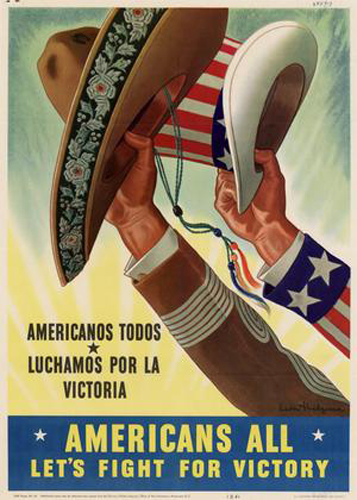Home Front Friday: Cuba Libre
Home Front Friday is a regular series that highlights the can do spirit on the Home Front during World War II and illustrates how that spirit is still alive today!
Within the last few months, the United States and Cuba began talks after years of relative silence between the two countries. Before Fidel Castro’s coup in 1959, however, the United States and Cuba were close allies, dating back to the Spanish-American War. During World War II, Cuba was one of the United States’ most dedicated allies as well. Cuba was the first Caribbean nation to declare war on the Axis powers, in December 1941.
While Cubans had America’s back during the War, Cuban-Americans and other Latino Americans helped tremendously abroad and on the Home Front as well. Approximately 500,000 Latinos, including 350,000 Mexican Americans and 53,000 Puerto Ricans, served in the American military during WWII. Latinos were never segregated into separate units, so exact numbers are more difficult to estimate than African-American involvement numbers.
In the Pacific, the 158th Regimental Combat Team, of which many men were Latino and Native American, fought in the Philippines. General MacArthur was so impressed with their performance that he called them “the greatest fighting combat team ever deployed in battle.” Latino soldiers were of particular aid in the defense of the Philippines because of their fluency in Spanish—American Latinos were able to understand and translate for the army in the Spanish speaking parts of the Philippines.
On the Home Front specifically, Latino men and women alike had extremely important roles for the Home Front. American Latinas served their country regardless of any cultural barriers that existed during the time. Bilingual Latinas often became linguists, nurses and Red Cross aids, and some even worked in the Marine Corps Women’s Reserve. Further, Latino men and women on the Home Front also worked on railroads, in mines, in shipyards, in airplane factories, and as agricultural laborers. By instating the Bracero Program, the US government granted work visas to 50,000 Mexican agricultural workers and 75,000 railroad workers during the war because of the labor shortage. These workers were necessary to the wartime driven economy, and the US likely would have had a much harder time without the Latino effort.
The Andrews Sisters were a popular group who frequently American entertained troops with their delightful voices. After their song “Rum and Coca-Cola,” the Cuba Libre, a drink originating in early 20th Century Cuba, grew in popularity in the United States.
To make a Cuba Libre, you’ll need:
- 4oz Cola
- 1/3oz fresh lime juice
- 1 2/3oz white rum
Pour all of the ingredients into a highball glass with ice. Garnish with a lime wedge.
Posted by Catherine Perrone, Education Intern and Lauren Handley, Assistant Director of Education for Public Programs at The National WWII Museum.
- Posted :
- Post Category :
- Tags :
- Follow responses to this entry through the RSS 2.0 feed. You can skip to the end and leave a response. Pinging is currently not allowed.





Leave a Reply